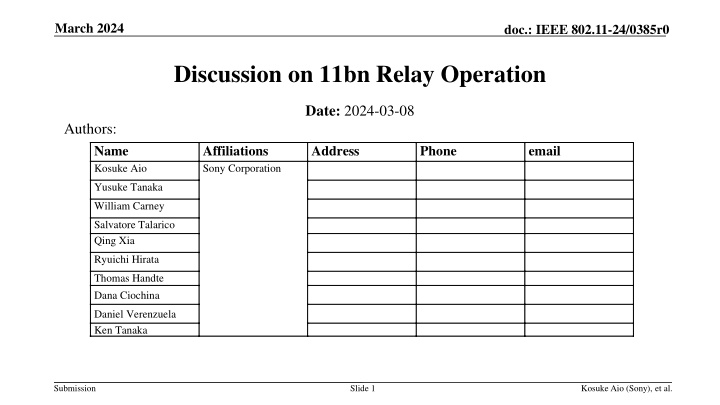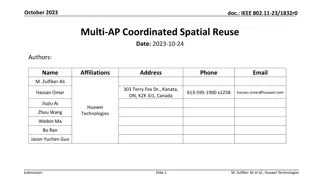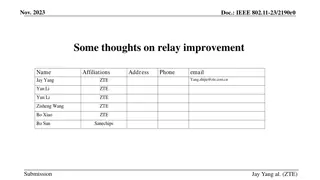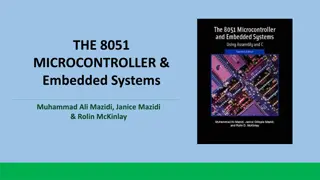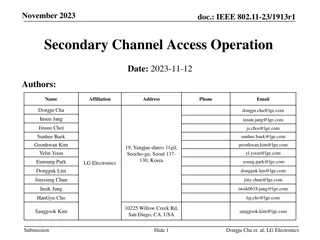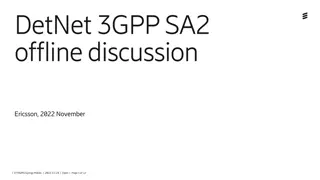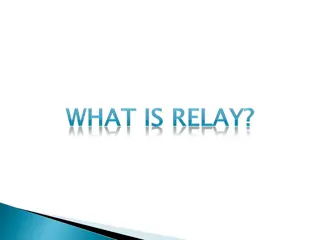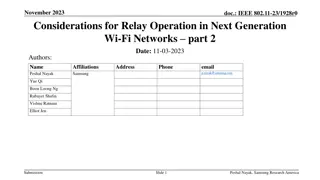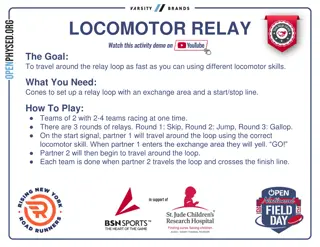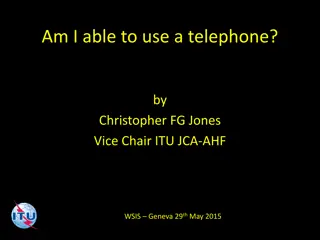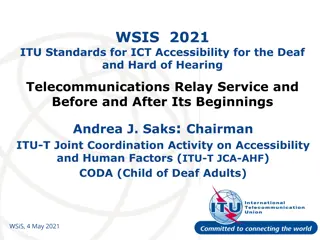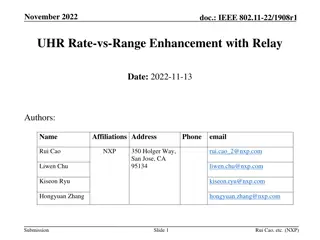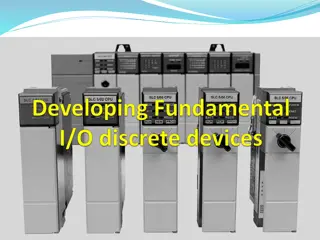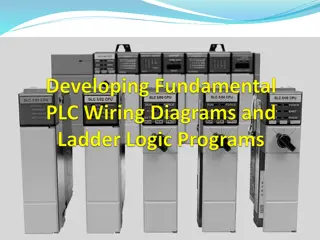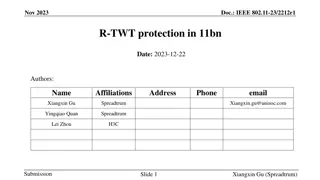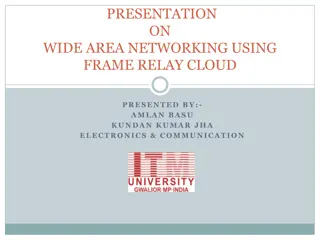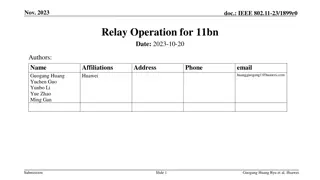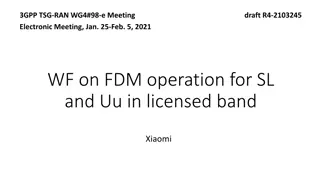Discussion on 11bn Relay Operation
This document discusses the 11bn Relay Operation within the IEEE 802.11 framework for improving Rate-vs-Range throughput. It covers the basic concepts, recap of current relay operations, and proposals for enhancing relay efficiency. Through simulations and analyses, the effectiveness of relay communication in enhancing throughput and signal strength for STAs is examined.
Download Presentation

Please find below an Image/Link to download the presentation.
The content on the website is provided AS IS for your information and personal use only. It may not be sold, licensed, or shared on other websites without obtaining consent from the author.If you encounter any issues during the download, it is possible that the publisher has removed the file from their server.
You are allowed to download the files provided on this website for personal or commercial use, subject to the condition that they are used lawfully. All files are the property of their respective owners.
The content on the website is provided AS IS for your information and personal use only. It may not be sold, licensed, or shared on other websites without obtaining consent from the author.
E N D
Presentation Transcript
March 2024 doc.: IEEE 802.11-24/0385r0 Discussion on 11bn Relay Operation Date: 2024-03-08 Authors: Name Kosuke Aio Affiliations Sony Corporation Address Phone email Yusuke Tanaka William Carney Salvatore Talarico Qing Xia Ryuichi Hirata Thomas Handte Dana Ciochina Daniel Verenzuela Ken Tanaka Submission Slide 1 Kosuke Aio (Sony), et al.
March 2024 doc.: IEEE 802.11-24/0385r0 Introduction UHR SG defines Rate-vs-Range throughput improvement as scope [1]. Relay communication is effective for improving Rate-vs-Range throughput [2] [5]. Relay communication to STAs that cannot receive signals from AP is expected to enable communication between AP and STAs. Relay communication to STAs with low SNR from AP is expected to improve throughput by improving SNR of STAs. In this contribution, we propose the basic 11bn Relay operation, and analyze the further discussion points for 11bn Relay operation by some simulations. Submission Slide 2 Kosuke Aio (Sony), et al.
March 2024 doc.: IEEE 802.11-24/0385r0 Recap on the Current Relay Operation Relay operation defined in the current 802.11 and WFA are shown in the table below. Spec Feature FD-AF FD-DF HD-AF HD-DF FD (Full Duplex) : Can transmit Fronthaul/Backhaul simultaneously (Both In-band and Out-band HD (Half Duplex) : Cannot transmit Fronthaul/Backhaul simultaneously AF (Amplify and Forward) : Received signals are amplified and relayed without decoding DF (Decode and Forward) : Received signals are decoded, re-coded, amplified and relayed WDS Mesh 802.11 DMG Relay S1G Relay WFA EasyMesh All are DF (Decoded and Forward) Relay, where Relay Node processes the relayed packets*1 up to the MAC layer before sending them to the Sink node*2. Routing is based on both IP address (L3 Relay) and MAC address (L2 Relay). The STA establishes a connection with the nearest AP (including Relay Node). Source Node*3 and Relay Node must obtain TXOP individually *1 Relayed Packets: Packets which Relay node must relay *2 Sink Node: Node device that finally receives the relayed packets *3 Source Node: Node device that first sends the relayed packets. Submission Slide 3 Kosuke Aio (Sony), et al.
March 2024 doc.: IEEE 802.11-24/0385r0 Proposal of Basic 11bn Relay Operation (1/2) 1. 11bn Relay Operation enables Relay Node to perform only a part of MAC processing of relayed packets. STAs can associate with AP other while also enabling DF Relay through Relay Node. At least, MAC Header and FCS check should be performed at Relay Node. Skipping a part of MAC processing at Relay Node creates several advantages: Skipping encryption/decryption reduces the time required for encryption-related processing. Skipping Reordering Buffer prevents a significant drop in throughput even if packet loss occurs before Relay packets are received.[6]. Submission Slide 4 Kosuke Aio (Sony), et al.
March 2024 doc.: IEEE 802.11-24/0385r0 Proposal of Basic 11bn Relay Operation (2/2) 2. 11bn relay operation allows Source node to use some scheme that shares TXOP to send relayed packets from Relay node in the same TXOP, provided that the backhaul/fronthaul is on the same link. [3,4,5] If Relay Node operates as an STA Entity, it can be expected to use11be TXOP Sharing (TXS). If Relay Node operates as an AP Entity, it can be expected to use enhanced TXS, enhanced R-TWT or Coordinated TDMA (C- TDMA) under discussion in TGbn. When Source Node is AP, it may be able to use this scheme for UL relay transmission as well [9] Submission Slide 5 Kosuke Aio (Sony), et al.
March 2024 doc.: IEEE 802.11-24/0385r0 Further Discussion Points.1: Intra/Cross-Link Relay Intra-Link Relay [3,5,7] Relay transmission using the same Link for Tx and Rx of Relay Node [Pros. ] Relay Node can be simplified, relayed packets transmission is possible reliably using some TXOP sharing function. [Cons.] Long transmission time (Huge throughput degradation) Cross-Link Relay [6,8] Relay transmission using the different Links for Tx and Rx of Relay Node [Pros.] Short transmission time (Little throughput degradation) [Cons.] MLO configuration is required for Relay Node. Depending on the status of Relay Node (channel and queue status), the transmission time may be longer than Intra-Link Relay. Cross-Link Relay Intra-Link Relay Submission Slide 6 Kosuke Aio (Sony), et al.
March 2024 doc.: IEEE 802.11-24/0385r0 Further Discussion Points.2: End-to-End(E2E) Ack Basically, Relay Node needs to relay Block Ack sent from Sink Node to Source Node (End-to-End Ack) [5]. Since the association is established between AP and STA, Block Ack agreement is also basically performed between them. Therefore, retransmission management between AP and STA is expected to reduce spec impact and simplify Relay Node. On the other hand, it is more efficient to use the normal block ack procedure between Source-Relay Node and Relay-Sink Node in the following cases: Relay Node has enough memory (buffer) to hold relay data. Source/Sink Node can detect the existence of Relay Node and can make Block Ack agreement individually. E2E Ack Normal Ack Submission Slide 7 Kosuke Aio (Sony), et al.
March 2024 doc.: IEEE 802.11-24/0385r0 Simulation Parameters Scenario Parameter (Data) 1500 byte 64 HE, 3.2us Guard Interval Fix: MCS7 (64QAM 5/6) 80MHz 1 10% For both Backhaul/Fronthaul Static value (from 0ms to 5ms) Packet Size Num. of Packets PPDU MCS BW Tx Spatial Stream Packet Error Rate Channel Access Delay Source Fronthaul Backhaul Sink Relay Same parameters of both backhaul/fronthaul Comparison 1. TDMA Relay vs. 11bn Relay onIntra-Link Relay 2. TDMA Relay vs. 11bn Relay onCross-Link Relay 3. 11bn Intra-Link Relay vs. 11bn Cross-Link Relay Above 11bn Relay is assumed to both E2E Ack and Normal Ack case Metric : Calculate the time required to complete all packet transmissions from Source Node (Transmission Latency) Submission Slide 8 Kosuke Aio (Sony), et al.
March 2024 doc.: IEEE 802.11-24/0385r0 Simulation Results.1: TDMA vs. 11bn Intra-Link Relay 95%-tile Transmission Latency vs. Channel Access Delay TDMA Intra-Link Relay After backhaul Tx is completed, wait for the channel access delay and then start the fronthaul Tx. 11bn Intra-Link Relay After backhaul Tx is completed, start the fronthaul Tx by using TXOP sharing. E2E Ack Case: Relay Node deletes relayed packets immediately after Fronthaul Tx (E2E Ack is required for ReTx) Normal Ack Case: Relay Node deletes relayed packets after Block Ack from Sink Node (E2E Ack is unnecessary for ReTx) In TDMA Relay, channel access delay leads directly to the transmission latency, while 11bn Relay, which can use TXOP sharing, is expected to have a certain transmission delay. When the channel access delay is small, E2E Ack of 11bn Relay can degrade the performance. Submission Slide 9 Kosuke Aio (Sony), et al.
March 2024 doc.: IEEE 802.11-24/0385r0 Simulation Results.2: TDMA vs. 11bn Cross-Link Relay 95%-tile Transmission Latency vs. Channel Access Delay TDMA Cross-Link Relay After waiting for the channel access delay, start fronthaul Tx of relayed packets acquired through backhaul Tx (If packet loss occurs during backhaul Tx, only packets with the previous SN of the lost packet can be transmitted.) 11bn Cross-Link Relay After waiting for the channel access delay, start fronthaul Tx of relayed packets acquired through backhaul Tx (All packets which Relay Node receives can be transmitted even if packet loss occurs during backhaul Tx.) E2E Ack Case: Relay Node deletes relayed packets immediately after Fronthaul Tx (E2E Ack is required for ReTx) Normal Ack Case: Relay Node deletes relayed packets after Block Ack from Sink Node (E2E Ack is unnecessary for ReTx) When the channel access delay is small (2.5~3ms), 11bn Relay can achieve higher performance than TDMA Relay by skipping Reordering Buffer. When the channel access delay is large (> 3ms), their performance is almost the same. Normal Ack has better performance than E2E Ack, but has less impact than Intra-Link Relay. Submission Slide 10 Kosuke Aio (Sony), et al.
March 2024 doc.: IEEE 802.11-24/0385r0 Simulation Results.3: 11bn Intra-Link vs. Cross-Link Relay 95%-tile Transmission Latency vs. Channel Access Delay 11bn Intra-Link Relay After backhaul Tx is completed, start the fronthaul Tx by using TXOP sharing. 11bn Cross-Link Relay After waiting for the channel access delay, start fronthaul Tx of relayed packets acquired through backhaul Tx (All packets which Relay Node receives can be transmitted even if packet loss occurs during backhaul Tx.) E2E Ack Case: Relay Node deletes relayed packets immediately after Fronthaul Tx (E2E Ack is required for ReTx) Normal Ack Case: Relay Node deletes relayed packets after Block Ack from Sink Node (E2E Ack is unnecessary for ReTx) 11bn Intra-link relay can reduce transmission latency more than11bn Cross-link relay when the channel access delay is large (around 3ms in this case). Submission Slide 11 Kosuke Aio (Sony), et al.
March 2024 doc.: IEEE 802.11-24/0385r0 Observation Intra-Link Relay vs. Cross-Link Relay 11bn Intra-link relay can reduce the transmission latency more than 11bn Cross-link relay when the channel access delay is large. This impact will vary with PPDU transmission time, i.e., payload size, number of aggregations, data rate, etc. E2E Ack vs. Normal Ack When packet errors occur on Backhaul Link, E2E Ack may increase the transmission latency compared to Normal Ack. Intra-Link Relay in particular has a greater impact. It is desirable to use these different methods depending on the transmission volume, capacity of the Relay Node, and channel conditions. When Relay Node can configure MLO and the number of relayed packets is large, Cross-Link Relay is preferrable. After backhaul Tx is completed, it is acceptable to switch to Intra-Link Relay after checking the channel status of Fronthaul Link. If Relay Node has enough memory, it is desirable to realize Normal Ack instead of E2E Ack. In this case, both AP/STA may need to make BA agreement with Relay Node separately. Submission Slide 12 Kosuke Aio (Sony), et al.
March 2024 doc.: IEEE 802.11-24/0385r0 Summary We proposed the basic 11bn Relay operation. Relay Node can perform only a part of MAC processing of relayed packets. Source Node can use some schemes to share TXOP for sending relayed packets from Relay Node in a TXOP in the only case backhaul/fronthaul are the same link. We analyzed the further discussion points for 11bn Relay operation by some simulations. 11bn Relay is expected to reduce transmission latency for both Intra- and Cross-Link Relay. Channel Access Delay increases the transmission latency of 11bn Cross-Link Relay and reverses Intra- Link Relay. Smaller packet have a greater impact. E2E Ack may increase the transmission latency compared to Normal Ack. Submission Slide 13 Kosuke Aio (Sony), et al.
March 2024 doc.: IEEE 802.11-24/0385r0 References [1] Laurent Cariou (Intel), UHR proposed PAR, 23/0480r3, July 2023 [2] Rui Cao (NXP), UHR rate-vs-range enhancement with relay, 22/1908r1, Nov 2022 [3] Dongguk Lim (LG Electronics), Features to consider for efficient Relay operation, 23/1138r1, July 2023 [4] Serhat Erkucuk (Ofinno), Relaying for Low Latency Traffic in UHR, 23/1146r1, July 2023 [5] Kiseon Ryu (NXP), UHR relay follow up, 23/1175r0, Aug 2023 [6] Kosuke Aio (Sony Corporation), Consideration on UHR Relay Architecture, 23/1969r0, Nov 2023 [7] Dongguk Lim (LG Electronics), Relay for 11bn, 23/1840r0, Nov 2023 [8] Guogang Huang (Huawei), Relay Operation for 11bn, 23/1899r0, Nov 2023 [9] Serhat Erkucuk (Ofinno), TXOP Sharing based UL Relaying, 23/1948r0, Nov 2023 Submission Slide 14 Kosuke Aio (Sony), et al.
March 2024 doc.: IEEE 802.11-24/0385r0 SP #1 Do you agree to support the following feature as new relay operation in TGbn? Relay node can perform only a part of MAC processing of relay data and performs relay operation A part of MAC processing is TBD Submission Slide 15 Kosuke Aio (Sony), et al.
March 2024 doc.: IEEE 802.11-24/0385r0 SP #2 Do you agree to support the following feature as new relay operation in TGbn? STA can use some TXOP sharing scheme to send relayed packets from Relay Node in a TXOP in the only case backhaul/fronthaul are the same link. Submission Slide 16 Kosuke Aio (Sony), et al.
